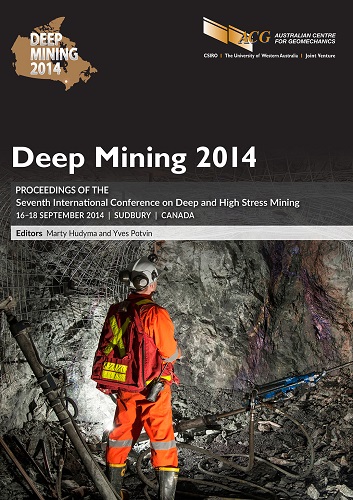Overcoming high temperature water ingress in deep shaft mining

|
Authors: Swanson, MT; Goodell, TM |
DOI https://doi.org/10.36487/ACG_rep/1410_53_Swanson
Cite As:
Swanson, MT & Goodell, TM 2014, 'Overcoming high temperature water ingress in deep shaft mining', in M Hudyma & Y Potvin (eds), Deep Mining 2014: Proceedings of the Seventh International Conference on Deep and High Stress Mining, Australian Centre for Geomechanics, Perth, pp. 741-755, https://doi.org/10.36487/ACG_rep/1410_53_Swanson
Abstract:
Resolution Copper Mining LLC, along with mining contractor Cementation USA, Inc., are in the process of developing what is planned to become the largest copper-producing mine in North America. A project of this magnitude does not come without challenges, and No. 10 Shaft, the first of six record-breaking shafts, has presented many. An impressive feat of engineering, the project will eventually use block caving methods to mine approximately 1.7 b t of porphyry copper ore at rates of up to 120,000 t per day. It will rely on the six 2,130 m deep shafts for ore extraction, ventilation, man access, and utilities. This paper will discuss the unique challenges faced during the sinking of No. 10 Shaft and the innovative thinking and engineering required to overcome them. These challenges include unexpected water ingress more than 1,950 m below surface. Within a 50 m section of shaft advance, water inflows increased from negligible amounts to totals in excess of 1,700 L per minute at temperatures exceeding 80°C. Attempts to reduce water ingress by pressure grouting were unsuccessful due to the highly fractured nature of the rock at this depth. In order for shaft sinking to continue, the water had to be efficiently handled and removed from the shaft using inventive and relatively unproven methods. Accompanying this water ingress was another unforeseen obstacle, a considerable heat load. Upon intersecting this high temperature water, shaft air temperatures and humidity levels immediately began to rise and continued to increase until worker safety became a concern. The shaft was generating a heat load of 6.61 MW, easily overwhelming a cooling system designed to handle less than half that amount. A complete overhaul of the shaft cooling and ventilation systems was required with just over 90 m of advance remaining to reach shaft bottom. This overhaul included the retrofitting of 610 of 2 m diameter vent duct in the shaft as well as the installation of six massive cooling coil units underground, weighing nearly 5,900 kg each. Together, the water and heat forced the project to drastically modify the shaft sinking process. Pump box-outs, hanging sumps, concrete-embedded dewatering lines, and dewatering buckets are a few items that have become irreplaceable parts of the sinking process at The Resolution Copper Project. While the remaining shafts will have the benefit of being better prepared to handle these obstacles, sinking with these exceptionally hot water inflows will never be considered routine. Numerous challenges remain for the project, challenges that will only be overcome by innovative thinking, adaptable operations, and ‘brute force engineering’.
© Copyright 2025, Australian Centre for Geomechanics (ACG), The University of Western Australia. All rights reserved.
View copyright/legal information
Please direct any queries or error reports to repository-acg@uwa.edu.au
View copyright/legal information
Please direct any queries or error reports to repository-acg@uwa.edu.au